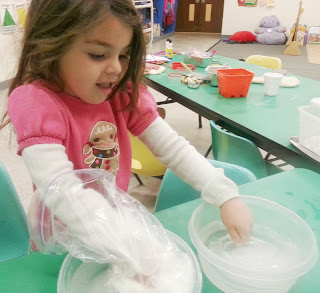I LOVE SCIENCE!!!! Yes, I declare myself an official science geek. Thanks to my all-time favorite 4th grade science teacher, Mr. Carly. His passion for teaching science and for his students was ADDICTIVE! I, literally, screamed with excitement when I learned that he was going to be my son's homeroom teacher. I hope and pray that my 2 girls have the same privilege.
Snow Melting Experiment
The preschoolers filled Styrofoam cups with snow.
We asked them to make hypotheses.... What will happen to snow when placed in the refrigerator until the next school day?
We asked them to make hypotheses.... What will happen to snow when placed in the refrigerator until the next school day?
Their responses:
It will freeze all up.
It will get really cold.
It will be frozen.
Their responses:
It will become ice cubes.
It will freeze all the way up.
It will be frozen.
We wrote names and hypotheses on their cups and placed the cups in the refrigerator and freezer. The next school day we made observations.
The snow in the refrigerator completely melted.
The snow in the freezer did not change.
Who knew shaving cream mixed with baking soda creates fake snow?!?!?
This process also causes an endothermic reaction, it's cold to the touch, making this activity even more fun.
This process also causes an endothermic reaction, it's cold to the touch, making this activity even more fun.
Step 1: Squirt the shaving cream on waxing paper.
Step 2: add 4 heaping tbsps. of baking soda. Add more as needed to create the perfect consistency.
S.M. pointed out the letter S on the Baking Soda box.
Step 3: Mix it up!
Some preschoolers opted to mix with a spoon....
Others decided to mix with their hands :)
We added the snow to our Snowman Bags.
This activity was pretty messy therefore, we brought the "sink" the them. D observed that the snow floats!
I found this original idea at www.growingajeweledrose.com
Ice Melting Experiment
I filled Tupperware containers with water and placed them outside to freeze in the 5 degree weather :)
The preschoolers squirted blue food coloring on one block of ice and orange on the 2nd block of ice.
They poured salt onto the top of the blue ice.
We asked them to make predictions, which ice block will melt first?
The boys agreed that the blue salty ice would melt 1st and the girls thought the orange unsalted ice would be the 1st to melt.
We made observations throughout the day.
We made observations throughout the day.
As the ice melted we looked closely at how the salt was melting the ice and discussed how salt is used on the streets and sidewalks, during the winter, to melt ice.
Polar Bear Science
Facts:
1 - The fur of a polar bear is hollow and transparent. We were tricked to think their hair is whitish because each hollow hair reflects the light, which causes the fur to appear white. Their hollow fur traps the heat of the sun to keep them warm.
2 - Polar bears fur is oily and water repellent.
3 - A Polar Bear's skin is black.
4 - Polar bear blubber is 4 inches thick, their blubber helps to keep them warm.
5 - Polar bears are excellent swimmers.
Activity 1
Blubber is beneficial when polar bears swim, keeping them warm in such cold water. We used Crisco in Ziploc bags to represent polar bears blubber.
Materials:
~ 2 Tupperware containers of ice and water
~ 1 gallon size Ziploc bag
~ 1 quart size Ziploc bag filled with shortening, butter or frosting (represents polar bear blubber)
~ 1 quart size Ziploc bag per student
~ shortening, butter or frosting (represents polar bear blubber)
Procedure: place the quart size, SEALED, Ziploc bag filled with shortening, inside the gallon size bag. Everyone will experiment with this set of bags.
Instruct the preschoolers to fill their quart size bags about 1/2 way with the shortening.
Then, secure the bags, unless you are okay with your preschoolers and your classroom covered in shortening. I learned, the hard way, the very first time I taught this lesson, I am NOT okay with everyone and thing covered in shortening:)
After their bags were filled and sealed, they labeled their bags with their initials.
We always hear squeals of excitement when we let them use Sharpies:)
Then, secure the bags, unless you are okay with your preschoolers and your classroom covered in shortening. I learned, the hard way, the very first time I taught this lesson, I am NOT okay with everyone and thing covered in shortening:)
The preschoolers take turns wrapping their bags around one hand, then placing it in the gallon size bag, containing the quart size, shortening filled, bag.
Place the blubber protected hand in 1 container of ice and water and the unprotected hand in the other container of ice and water. Discover how the blubber indeed shields polar bears from the cold water!
Activity 2
Polar Bear Fur Insulation Experiment
Polar Bear Fur Insulation Experiment

Materials: balloons, ice, water
Procedure:
1 ~ Help each preschooler slip 2 balloons on 1 of his/her fingers.
2 ~ Invite the preschoolers to place an unprotected finger in the ice water and the "fur protected" finger in the water.
The preschoolers will notice the "fury fingers" feel protection from the icy cold water and the fur repels water to help keep their skin dry.
Conclusion:




















































No comments:
Post a Comment